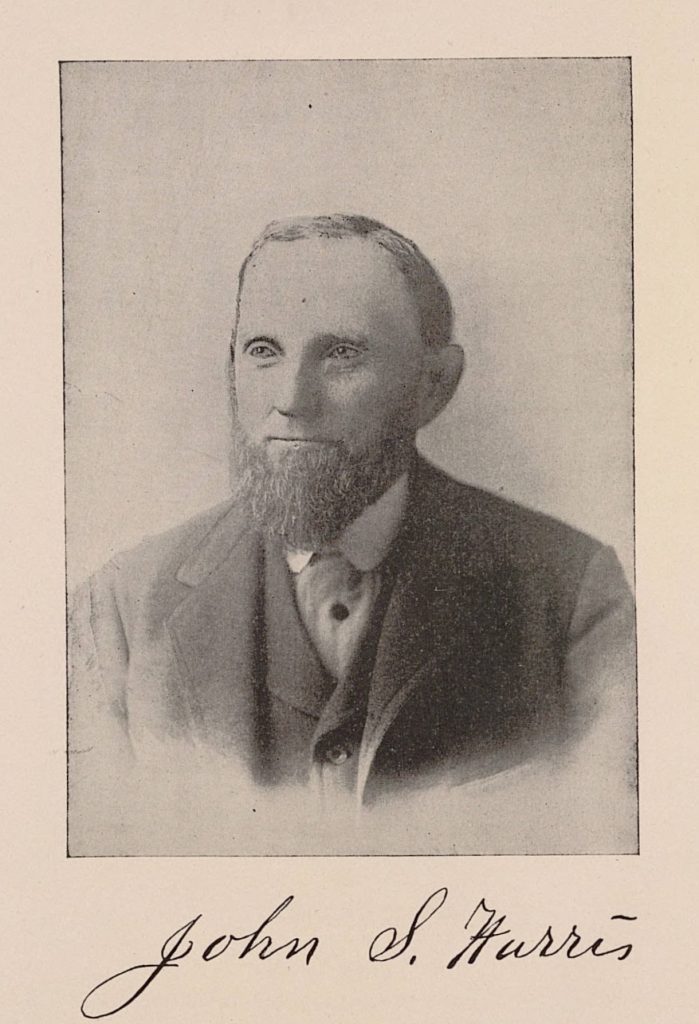John S. Harris
John S. Harris’ initials appear next to nearly every apple entry. The following is a 1892 biographical sketch of John S. Harris from the Minnesota State Horticultural Society. He died in Minnesota in 1901.

Through the medium of the agricultural press, the reports of the Minnesota, Wisconsin and other state horticultural societies and the American Pomological Society, the name of John S. Harris, La Crescent, Minn., has become familiar to all the people of the Northwest who take an interest in horticulture, pomology, forestry or anything pertaining to progressive agriculture.
Mr H. was born in Seville, Medina Country, Ohio, August 17, 1826. He is a descendant of a family that has always maintained an honorable record as agriculturists and artisans, that class and rank upon which the strength, stability and perpetuity of our country’s institutions rest, and with patriotism and loyalty to those institutions, that enabled them to make any sacrifice in their defense. His ancestors were amount the founders and defenders of this republic, and his parents, Samuel Harris of Connecticut and Mabel Gibbs of Massachusetts, were among the hardy pioneers who felled the forests of northern Ohio to carve out farms and homes and lay the foundations of the present prosperity of that great state. His father was a thorough and practical farmer, and an enthusiastic pomologist and gardener. At a very early age the lad, John S., exhibited a great love for horticulture, and, under his father’s instruction and a diligent study of the meager horticultural literature that found its way to western homes in that early day, soon become a skillful propagator of trees and plants, and at the early age of 11 years started ans managed a nursery and garden of his own. He remained upon the farm until the death of his father in 1844, when, following the advice of his guardian, he served an apprenticeship to learn the cabinet maker’s trade; but during that time improved every opportunity to practice his favorite pursuit.
In the spring of 1847, he enlisted as a private in Company “H,” 15th U.S. Infantry, to serve in the war with Mexico; went forward with his regiment, joined Gen. Scott at Pueblo and was with him in the campaign that resulted in the capture of the city of Mexico. After his return from Mexico he remained in Ohio about one year, then took a trip west and making his headquarters in Walworth County, Wis., spent much time traveling over Wisconsin, northern Illinois and Iowa, at the time a new and sparsely settled country, making long journeys on foot, often with no companion except a faithful dog and trusty rifle, the object being to recover his health which had been badly wrecked in the hardships and privations of the Mexican campaign. In the summer of 1851 he landed in La Crosse still in poor health and with a cash capital of just one shilling, where, after working at carpentering or anything else that turned up for nearly two years, he engaged in the market gardening business. Finding the sandy soil at La Crosse not reliable for gardening or adapted to fruit culture, he removed to La Crescent and started a general gardening, fruit growing and florist business. He planted his first orchard in 1857, and has continued to plant more or less trees every year since, making his place virtually a Minnesota horticultural experiment station in which has been planted for trial every choice American variety of apples of which trees could be procured, together with pears, plums, cherries, grapes and other small fruits. He has been twice, in the winters of 1972-3 and 1884-5, nearly conquered and cleaned out by the elements, but has never surrendered to them.

He began to attend fairs and exhibit fruit of his own growing in 1864, and has followed it up down to the present time without a break of a single year. At the state fair held in Rochester in October, 1866, he made the largest exhibit of home grown fruit that has been made in the state, and assisted in the organization of the society, the first name on the role; he has continued a steadfast and active member. In September, 1868, he was elected vice-president of the society, and in October, 1889, president, and held the office until January, 1871. He was then made corresponding secretary, holding the office two years, and was then elected secretary for one year, and edited the second volume of transactions. Again from 1881 to 1884, he was president of the society, and has since been a member of the executive committee. In 1875, he was elected a member of the board of the State Agricultural Society, and held the position twelve years. His has been an active life; beginning without any capital, except the knowledge of business, and the help of a willing and frugal wife, he has created a comfortable home in one of the most beautiful spots in the Mississippi valley, and yet has found time to do much for the advancement of agriculture and horticulture, and has spoken and written much upon these subjects during the last thirty years, and for many of the time the writing and study was done at night after long days of hard toll. His school education was limited to the most common English branches that were taught in the common schools of the day, but he has never ceased to continue to educate himself by reading and studying nature. Mr. Harris was married in December, 1850, to Miss Melissa J. Clayton of Montgomery County, N.Y. She is still living. The fruit of this union is two sons and two daughters, all living and settled in Houston County.
Annual Report of the Minnesota State Horticultural Society, 1892, Volume XX
Edited by the Secretary, A.W. Latham, Excelsior Minn.
Download the entire report from Minnesota Reflections through Minnesota Digital Library

